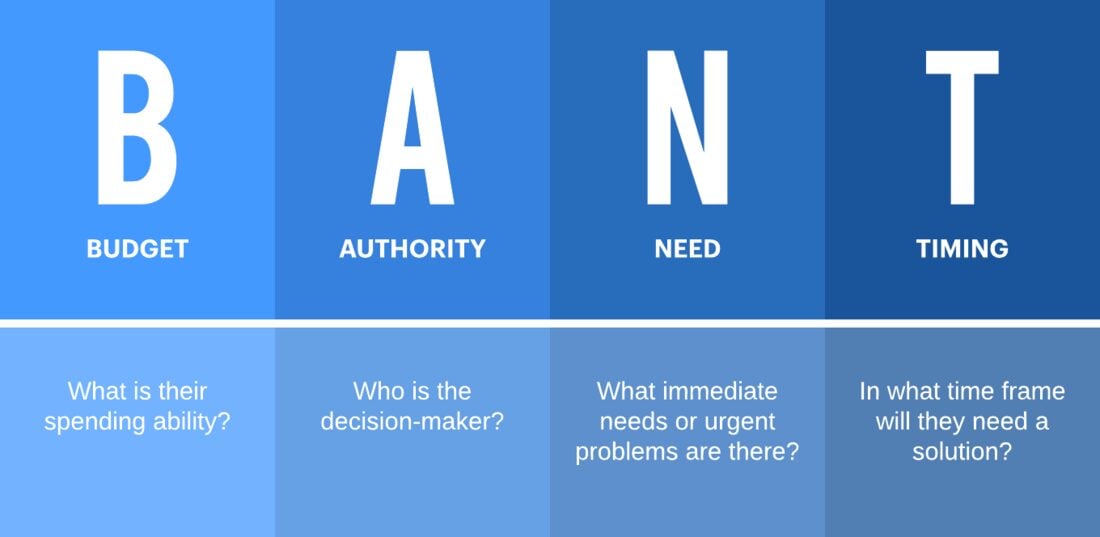Il existe de nombreuses stratégies et processus de vente respectés et couronnés de succès, mais un style est souvent cité comme l'un des meilleurs - BANT.
En 2024, la vente sera probablement perçue comme plus automatisée et, dans une moindre mesure, plus facile que par le passé. Cependant, ce n'est pas la réalité. Bien qu'il y ait plus d'opportunités et plus de produits à acheter et à vendre, il est plus difficile de vendre aujourd'hui parce que les comportements d'achat traditionnels ont évolué de manière exponentielle ces dernières années.
Être capable de qualifier efficacement un prospect reste un élément clé d'un bon professionnel de la vente. Et dans un monde où les attentes des clients sont plus élevées que jamais, et où la concurrence est plus féroce que jamais - que ce soit en B2B ou en B2C - c'est encore plus important.
Autrefois, les prospects se fiaient à ce que leur disait un vendeur, mais aujourd'hui, les données et les informations sont facilement accessibles par simple pression d'un bouton. Les prospects sont mieux informés et ont souvent pris de nombreuses décisions dans le cadre du processus d'achat avant même que le représentant commercial ne leur parle. Il y a aussi tout un flot d'informations qui peuvent influencer le choix. Les sites web, les médias sociaux et toute une série de canaux d'achat différents font que, même dans un délai d'exécution traditionnellement long, la rapidité reste de la plus haute importance.
Dans ce guide, vous découvrirez ce qu'est exactement le cadre BANT, comment il peut être mis en œuvre dans les processus de votre équipe de vente, pourquoi il est efficace de le faire, et quelques critères utiles pour évaluer s'il est pertinent pour votre équipe de vente ou non.
Qu'est-ce que le cadre BANT ?
Le cadre BANT est une approche de la vente qui a fait ses preuves. Il signifie Budget, Autorité, Besoin et Délai. Chaque section joue un rôle essentiel pour déterminer si votre client potentiel est susceptible d'effectuer un achat et s'il est en mesure de le faire. Le cadre passe du prospect individuel à l'entreprise, ce qui permet d'obtenir une image complète du client potentiel et de déterminer s'il vaut la peine d'y donner suite.

La décomposition de chaque section est essentielle et ne peut être omise :
Budget
La compréhension du budget d'un prospect est l'un des éléments les plus importants de ce processus de qualification. Il s'agit d'évaluer si le prospect dispose des ressources financières nécessaires pour investir dans votre produit ou service. Cela permet d'éviter qu'un prospect n'aille trop loin, ne prenne du temps et des ressources de l'équipe de vente, et ne soit ensuite considéré comme n'ayant pas les moyens d'acheter le produit ou le service.
Autorité
Lorsque vous traitez avec quelqu'un, il est extrêmement important d'identifier si la personne à qui vous parlez est le décideur ou si elle fait partie du processus de décision. Sans cette étape, un prospect peut se retrouver tout en bas de l'entonnoir et ne pas avoir l'autorité nécessaire pour signer un achat. Cela peut être dû à la hiérarchie interne ou, parfois, au fait qu'une personne trouve trop gênant d'admettre qu'elle n'est pas la personne qui doit prendre la décision. En vous assurant que vous avez non seulement un décideur, mais aussi au moins une idée des autres décideurs, vous avez beaucoup plus de chances d'avoir un processus de clôture transparent. Même si l'entreprise est prête à acheter, le fait de ne pas traiter directement avec un décideur est susceptible d'entraîner des retards.
Besoin
Il est essentiel d'être en mesure de déterminer s'il existe un besoin. Si vous n'êtes pas certain qu'il s'agit d'un véritable besoin, ou d'un besoin perçu comme tel, il peut être plus difficile de mettre l'accent sur la valeur de l'offre. Par ailleurs, si vous souhaitez adopter une approche centrée sur le client, le besoin du client doit être au premier plan de votre réflexion. Le fait de pouvoir résoudre un problème potentiel ouvre la voie à une vente réussie.
Chronologie
Là où beaucoup de représentants et d'équipes de vente échouent, c'est qu'ils prennent ce qui précède et n'essaient pas de déterminer quel est le calendrier. En utilisant les critères ci-dessus, un représentant peut encore identifier un besoin, l'autorité, le budget, mais s'il est à 6 mois, 12 mois, etc. de l'achat, cela peut faire perdre du temps. Il se peut qu'au moment où le client est prêt à acheter, les circonstances aient changé et que les critères précédents ne soient plus valables. Il est également important d'obtenir cette information pour s'assurer que vous resserrez et optimisez le cycle de vente et l'allocation des ressources.
Comment intégrer Bant dans votre processus de vente
Il existe de nombreuses façons d'intégrer les BANT dans votre processus de vente, notamment en utilisant des modèles et des conseils de vente pilotés par l'IA. Cela peut se faire lentement ou très rapidement. Les étapes restent les mêmes, mais la manière dont elles sont exécutées peut être très différente.
Le premier exemple consiste à couvrir toutes les étapes du premier contact avec un prospect. Cela ne convient pas à toutes les entreprises, mais si vous vendez en grande quantité et dans des délais rapides, cela pourrait être une bonne approche pour inclure les BANT. Les BANT peuvent ensuite être répétés tout au long du processus.
EXEMPLE 1 - Le cycle SaaS "rapide
Un nouveau responsable commercial travaillant dans une société SaaS qui vend des logiciels de suivi pour les entreprises pourrait effectuer des appels sortants à froid pour l'équipe de vente afin d'organiser des démonstrations. Avant que le cadre ne puisse réserver une réunion, il doit poser quelques questions de qualification avant de pouvoir fixer la réservation dans un agenda.
Il peut s'agir de questions telles que
Votre entreprise travaille-t-elle dans le domaine du commerce interentreprises ?
(BESOIN - Le produit est uniquement b2b, s'il est b2c, il n'y a pas de besoin).
Disposez-vous d'un site web actuel ?
(NÉCESSAIRE - S'ils n'ont pas de site web, l'outil leur est inutile).
Êtes-vous en mesure d'ajouter du code javascript à votre site web ? Ou avez-vous quelqu'un en interne qui peut le faire ?
(AUTORITÉ - Peuvent-ils apporter des modifications à un site ? Ou ont-ils le pouvoir de demander à quelqu'un de le faire pour eux).
Êtes-vous en mesure de prendre une décision concernant l'achat du logiciel ? Et si oui, y a-t-il d'autres personnes qui doivent être impliquées dans le processus de prise de décision et que nous pouvons inviter à la démonstration ?
(AUTORITÉ - Ont-ils l'autorité ? Et si oui, y a-t-il quelqu'un d'autre ? Cela permet d'éviter qu'une affaire soit conclue et qu'une nouvelle personne doive être intégrée ultérieurement et mise au courant de la situation).
Quel type de marketing pratiquez-vous actuellement ?
(BUDGET - S'ils investissent déjà dans le marketing, cela les qualifie. Si ce n'est pas le cas, il ne s'agit pas d'une rupture d'accord, mais dans les notes, le représentant pourrait approfondir la question pour avoir une idée de leur budget et de la raison pour laquelle il est différent).
Seriez-vous intéressé par la mise en œuvre de cette mesure au cours de ce trimestre ?
(ÉCHÉANCIER - Identifier et déterminer si le client est prêt à acheter maintenant ou s'il attend plus tard. Il ne s'agit pas nécessairement d'une rupture de contrat, mais le cadre peut alors indiquer dans ses notes que le représentant commercial doit insister davantage sur ce point pour obtenir un calendrier solide).
Bien que ces questions soient assez détaillées et que beaucoup aient l'impression de perdre un prospect potentiel en les posant, elles permettent de détecter d'éventuels problèmes avant que trop de temps ne soit consacré à une démonstration, par exemple. Ces questions constituent également de bons points de discussion que le directeur commercial pourra aborder lors de l'entretien suivant, afin de confirmer et d'affermir ces points.
Il ne s'agit là que d'une des façons d'intégrer le cadre BANT dans votre processus de vente, mais il y a plusieurs autres façons de le faire.
EXEMPLE 2 - Intégration étendue de BANT pour les ventes d'équipements de grande valeur
Imaginez une entreprise spécialisée dans la vente de systèmes de forage au diamant avancés, utilisés principalement dans les projets de prospection géologique à grande échelle et les opérations minières. Ces systèmes représentent un investissement important et nécessitent un processus de vente détaillé et étendu qui peut s'étendre sur plusieurs mois, voire plusieurs années.
Recherche initiale et identification
L'équipe de vente commence par identifier les clients potentiels en consultant des rapports sur l'industrie minière, des salons professionnels et des partenariats stratégiques avec des sociétés d'études géologiques. Elle cible les entreprises qui ont récemment obtenu des droits d'exploitation minière ou qui ont annoncé des plans d'expansion - des indicateurs clés d'un budget et d'un besoin potentiels.
Sensibilisation et engagement initiaux
Le représentant commercial envoie une campagne de courriels personnalisée, axée sur les développements récents de l'industrie et les innovations en matière de technologie de forage au diamant. La communication initiale est conçue pour susciter l'intérêt et jeter les bases d'un engagement plus profond.
Invitation à un webinaire éducatif
Afin d'impliquer davantage les prospects et de leur apporter une valeur ajoutée dès le départ, l'entreprise les invite à un webinaire exclusif qui aborde les dernières tendances en matière de forage au diamant et explique comment les technologies de pointe peuvent réduire considérablement les coûts d'exploitation et accroître l'efficacité.
Appel à la découverte détaillée
Après le webinaire, les prospects intéressés sont invités à un appel de découverte au cours duquel le représentant commercial utilise le cadre BANT :
Budget: Le représentant demande : "En fonction de vos plans d'expansion actuels, avez-vous alloué un budget pour la mise à niveau ou l'acquisition de nouveaux systèmes de forage ?"
Autorité: Au cours de la conversation, il identifie les principales parties prenantes, en demandant : "Qui d'autre dans votre équipe devrait participer à notre prochaine discussion pour aider à évaluer cette technologie ?"
Besoin: Ils explorent les défis opérationnels spécifiques auxquels le prospect est confronté, en demandant par exemple : "Quelles sont les limites que vous rencontrez avec votre équipement de forage actuel ?"
Calendrier: Le calendrier étant crucial, ils posent la question suivante : "Quand prévoyez-vous de commencer votre prochain grand projet de forage ?"
Démonstration de la solution et visite du site
Les prospects intéressés se voient proposer une démonstration en direct sur le site d'un client existant. Cela leur permet de voir le système de forage au diamant en action et de comprendre directement ses avantages opérationnels. Des présentations personnalisées montrent comment la technologie peut s'intégrer à leurs opérations actuelles, répondre à leurs besoins et rester dans les limites de leur budget.
Personnalisation et négociation de la proposition
Sur la base des informations recueillies au cours des interactions précédentes, une proposition détaillée est élaborée. Cette proposition aligne les capacités du produit sur les exigences spécifiques et le budget du prospect. Les négociations peuvent se dérouler en plusieurs étapes, en mettant l'accent sur les conditions de paiement, la formation et le soutien après-vente, afin de s'assurer que tous les décideurs sont d'accord.
Planification de la clôture et de la mise en œuvre
Une fois l'accord obtenu, le processus de vente passe à la conclusion, avec des plans détaillés pour la livraison, l'installation et la formation sur site. L'équipe de vente reste activement impliquée, assurant une transition en douceur et répondant à toutes les questions d'après-vente.
Relations et soutien continus
Après la vente, l'entreprise entretient une relation solide avec le client, en lui fournissant des mises à jour régulières sur les nouvelles améliorations et un soutien proactif en matière de maintenance. Cet engagement continu ouvre la voie à de futures mises à niveau et à des références au sein de l'industrie.
Cet exemple illustre une approche beaucoup plus détaillée de l'intégration du cadre BANT dans les situations de vente à forte valeur ajoutée, en veillant à ce que chaque interaction apporte une valeur ajoutée et contribue à la réussite d'un partenariat à long terme.
Conseils pour maintenir la cohérence de l'utilisation de BANT dans les différentes équipes de vente
Comme vous pouvez le constater, le BANT est assez universel et peut même s'appliquer aux ventes B2C, par exemple à une personne cherchant à acheter une nouvelle cuisine. Il est donc essentiel de s'assurer que votre processus de vente se déroule comme il se doit, et il existe quelques idées clés sur la façon de maintenir cette cohérence.
Formation et remise à niveau régulières : Organisez des sessions de formation à la vente pour les nouveaux embauchés et des cours de remise à niveau pour les membres de l'équipe en place afin de vous assurer que tout le monde comprend et peut appliquer efficacement le cadre BANT.
Utilisez les outils de gestion de la relation client : Veillez à mettre en place des outils de gestion de la relation client (CRM) pour suivre et enregistrer les critères BANT de chaque prospect. Cela permet de maintenir la cohérence dans la manière dont les informations sont collectées et utilisées par les différentes équipes de vente.
Exercices de jeu de rôle : Mettez en place des scénarios de jeu de rôle qui permettent aux équipes de vente de s'entraîner à utiliser les BANT dans diverses situations de vente. Cela permet de renforcer la confiance et d'appliquer le cadre de manière plus efficace.
Retour d'information et amélioration continue : Recueillir régulièrement les commentaires de l'équipe de vente sur l'application du cadre BANT et apporter les ajustements nécessaires au processus. Cela permet d'affiner l'approche et d'améliorer les résultats des ventes.
BANT pour améliorer l'efficacité des ventes
Nous avons appris que le BANT est un moyen fantastique de s'assurer que les pipelines sont remplis de prospects bien qualifiés qui montrent au moins quelques signaux d'achat. Il y a de nombreuses raisons pour lesquelles nous voulons nous assurer que nos équipes de vente travaillent avec une efficacité et une productivité maximales. Voici quelques exemples de la façon dont il peut rendre les ventes plus efficaces et plus productives.
Qualification ciblée des prospects
En appliquant les critères BANT, les équipes de vente peuvent rapidement discerner les prospects les plus susceptibles de se convertir. Les efforts de vente sont ainsi concentrés sur les prospects qui sont non seulement intéressés, mais aussi en mesure de prendre des décisions d'achat, ce qui permet de gagner du temps et d'augmenter les taux de conversion.
Allocation optimisée des ressources
Comprendre les besoins spécifiques et les délais des clients potentiels permet aux responsables des ventes d'allouer les ressources de manière plus stratégique. Les équipes peuvent donner la priorité aux prospects à fort potentiel qui nécessitent une attention immédiate tout en programmant des suivis pour les opportunités à long terme, garantissant ainsi que chaque prospect est entretenu en fonction de sa valeur potentielle.
Amélioration des indicateurs de vente
La mise en œuvre de BANT permet de suivre et d'améliorer les indicateurs de vente essentiels tels que les taux de conversion des prospects, la longueur des cycles de vente et la taille des transactions. Lorsque les équipes se concentrent sur des pistes bien qualifiées, la probabilité de conclure une affaire augmente, ce qui stimule les performances et l'efficacité des ventes en général.
Cohérence entre les équipes
La cohérence de la qualification des prospects entre les différentes équipes de vente est vitale pour un succès évolutif. BANT fournit un cadre clair et standardisé que tous les membres de l'équipe peuvent suivre, ce qui permet de maintenir une approche uniforme de l'évaluation et de l'engagement des prospects. Cette standardisation est particulièrement bénéfique dans les grandes entreprises où plusieurs équipes ou départements gèrent différentes étapes du processus de vente.
L'adoption du BANT permet non seulement de mieux cibler les équipes de vente, mais aussi d'améliorer la productivité globale en veillant à ce que chaque interaction soit stratégiquement alignée sur les objectifs de vente de l'entreprise. Cette approche méthodique de la qualification des prospects s'avère indispensable pour obtenir de meilleurs résultats commerciaux et une plus grande efficacité opérationnelle.
Défis et limites du BANT dans les ventes modernes
Cependant, bien qu'il soit facile de supposer que BANT est la réponse à tous vos besoins en matière de vente, il comporte certains facteurs limitatifs. Voici quelques-uns des éléments à prendre en compte lorsque l'on décide d'utiliser le cadre BANT.
Le parcours de l'acheteur évolue
Tout simplement parce que depuis l'essor de l'Internet , le cycle de vente traditionnel, théorisé depuis de nombreuses années, s'est modifié. Il ne s'agit plus d'une simple recherche suivie d'un achat, mais la boucle de vente commence à la fois plus loin et plus loin. Vous trouverez ci-dessous un graphique qui illustre à quel point la situation est différente aujourd'hui.

L'élément budgétaire peut être mal interprété
Certains acheteurs ne veulent pas donner leur budget dès le départ, ce qui pourrait les disqualifier. De même, un acheteur peut donner la fausse impression qu'il dispose d'un budget. Bien que cela soit certainement vrai pour presque toutes les ventes, qu'il s'agisse de la méthode BANT ou non, il s'agit d'un élément clé du cadre qui est susceptible de poser des problèmes.
Défis de l'autorité
De même, un représentant commercial ou une personne peut demander à ce que le décideur soit impliqué et ils ne veulent tout simplement pas s'en préoccuper tant que l'affaire n'est pas presque conclue. C'est pourquoi l'utilisation d'assistants de réunion IA peut aider à intégrer les personnes et à les mettre au courant. De même, il peut y avoir deux décideurs qui ont des points de vue opposés.
Une importance excessive accordée aux besoins, ou aux besoins perçus comme tels
En se concentrant fortement sur les besoins présumés des clients, les commerciaux peuvent négliger leurs véritables exigences, ce qui se traduit par des propositions qui ne correspondent pas à leurs priorités. Les commerciaux ont souvent l'impression que les clients mentent, non pas intentionnellement, mais parce qu'ils se focalisent sur un seul problème plutôt que sur leurs véritables points de douleur. La méthode BANT, bien qu'elle permette de discerner les problèmes, peut parfois donner lieu à de fausses réponses.
Différences culturelles et de marché
L'efficacité de la BANT peut varier considérablement d'une culture à l'autre et d'un marché à l'autre. Dans certaines cultures, les questions directes sur le budget et le pouvoir de décision peuvent être considérées comme impolies ou agressives, ce qui peut nuire à la relation.
Si les BANT restent un outil précieux pour qualifier les prospects, ces défis soulignent l'importance de les utiliser avec souplesse et en conjonction avec d'autres stratégies qui prennent en compte le contexte plus large des environnements de vente modernes. Adapter l'application de la BANT au contexte commercial spécifique et à l'évolution du paysage des relations avec les clients peut contribuer à atténuer ces difficultés.
La BANT est-elle adaptée à votre entreprise ?
Pour déterminer si le cadre BANT est adapté à votre stratégie de vente, il faut évaluer divers aspects de votre processus de vente, les conditions du marché et le comportement des clients.
Avant de décider d'adopter cette approche, il convient de se poser quelques questions clés :
- Votre activité implique-t-elle des cycles de vente complexes qui nécessitent une qualification approfondie des prospects ? BANT est particulièrement utile dans les environnements où l'identification précoce des acheteurs sérieux permet de gagner du temps et d'économiser des ressources.
- Vos personas d'acheteurs sont-ils bien définis et ont-ils des budgets, des pouvoirs, des besoins et des calendriers clairs ? BANT fonctionne mieux lorsque ces facteurs sont identifiables et influencent la décision d'achat.
- La taille moyenne de vos transactions est-elle suffisamment importante pour justifier un processus de qualification intensif ? Pour les transactions de grande valeur, s'assurer que tous les critères BANT sont remplis peut s'avérer crucial pour une vente réussie.
- Vous concentrez-vous sur l'établissement de relations à long terme avec vos clients plutôt que sur des transactions ponctuelles ? Si c'est le cas, assurez-vous que BANT est utilisé de manière flexible afin de ne pas rater le développement de prospects qui pourraient s'avérer précieux au fil du temps.
- Les ventes dépendent-elles souvent de l'accès aux principaux décideurs et de l'influence qu'ils exercent sur eux ? BANT vous aide à déterminer si votre contact dispose de l'autorité nécessaire ou si d'autres parties prenantes doivent être impliquées.
- Votre équipe de vente dispose-t-elle de ressources limitées qui doivent être soigneusement allouées aux prospects les plus prometteurs ? BANT peut vous aider à prioriser vos efforts en fonction du potentiel de chaque prospect.
- Votre marché est-il bien compris et relativement stable ? Sur ce type de marché, le BANT peut être efficace car les besoins et les délais des clients sont plus clairs et plus prévisibles.
- L'approche par questions directes de BANT est-elle appropriée et efficace dans votre culture d'entreprise et dans la culture du marché au sens large ?
- Les BANT s'inscrivent-elles dans votre stratégie et vos objectifs de vente globaux ? Bien que les BANT s'accordent bien avec d'autres approches commerciales telles que la vente SPIN, assurez-vous qu'elles soutiennent vos objectifs stratégiques plutôt que de les contredire.

La vente SPIN peut-elle améliorer votre efficacité commerciale ? Découvrez comment cette technique éprouvée vous permet d'entrer directement en contact avec les décideurs et de conclure plus rapidement des affaires plus importantes.
Une utilisation réussie de BANT
Si vous avez décidé que la stratégie BANT pourrait vous être très utile et vous permettre d'atteindre les objectifs de votre entreprise, vous vous inscrivez dans une longue lignée d'entreprises qui pensent de même. L'intérêt de la stratégie BANT est qu'elle est assez universelle. Comme nous l'avons vu dans ce guide, elle peut être utilisée pour vendre des logiciels et des forages au diamant, et peut même être utilisée en B2C.
Qu'il s'agisse de cycles SaaS rapides ou de transactions à forte valeur ajoutée, BANT propose une approche structurée pour naviguer dans les méandres de la vente moderne et favoriser les relations à long terme avec les clients.





